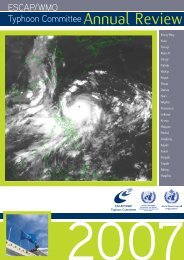TCAR - Typhoon Committee
TCAR - Typhoon Committee
TCAR - Typhoon Committee
Create successful ePaper yourself
Turn your PDF publications into a flip-book with our unique Google optimized e-Paper software.
Strategic Plan and progress on the 2009 <strong>Typhoon</strong><br />
<strong>Committee</strong> Annual Operating Plan goals)<br />
a. Meteorological Achievements/Results<br />
Improvement in Marine Observation System<br />
By the end of 2009, 191 Shore-based stations and<br />
84 island AWSs had been set up. Recently, 17 buoys,<br />
2 storm surge stations, 6 oil drilling platform-based<br />
stations and 4 ship stations are under construction,<br />
out of which the 6 buoy stations become operational.<br />
Improvement in Upper Air Observing System<br />
In 2009, 27 upper air stations were up-graded by<br />
L-band radar-based upper air observing systems.<br />
Improvement in Radar Observing System<br />
156 Doppler weather radars have been already<br />
installed in China for observing precipitation,<br />
rainstorms and typhoons by 2009. They further<br />
improved the capability in monitoring typhoons along<br />
the Chinese southeast coasts, among others.<br />
In 2009, a plan for installing additional 58 newgeneration<br />
Doppler weather radars has been approved<br />
by government to improve monitoring, forecasting and<br />
warning of severe weather events. According to the<br />
latest plan, 8 CINRAD radars will be set up in 2010.<br />
Improvement in Satellite Observing System<br />
The FY-2E satellite of the FY-2 geostationary<br />
meteorological satellite series has been delivered to<br />
the China Meteorological Administration (CMA) from<br />
the State Administration of Science, Technology and<br />
Industry for National Defense on 19 May 2009. FY-<br />
2E is the third satellite of the FY-2 series and is the<br />
successor of FY-2C and FY-2D. FY-2E has been<br />
successfully launched in Xichang Satellite Launch<br />
Centre on 23 December 2008 and located at 123.5ºE<br />
in the orbit on 27 December 2008. The satellite has<br />
such features as follows:<br />
• Observation ability: satellite-borne scanning<br />
radiometer.<br />
• Able to obtain a panoramic picture an hour in the<br />
none-flooding season and a picture half an hour<br />
in the flooding season covered about 1/3 earth.<br />
• Data collection ability: various ground data<br />
collection platform deliver meteorology, hydrology,<br />
ocean and environment data et al, then digitize all<br />
kinds of obtained data, modulate UHF frequency<br />
and send to application system via FY-2E satellite.<br />
Receive and demodulate data in the CDAS, then<br />
deliver them to the data processing centre.<br />
<strong>TCAR</strong><br />
CHAPTER 1 - TYPHOON COMMITTEE ACTIVITIES<br />
• Production distribution ability: application system<br />
applies the stretching and section pictures,<br />
quantitative product and platform data produced<br />
by the satellite observation data to the user via<br />
broadcasting-satellite channel and other means<br />
of communication.<br />
• Stretched picture broadcasting ability: stretching<br />
picture broadcasting is generated by the<br />
application system while the satellite scanning<br />
and observing the earth. The application system<br />
processes the observation data and then produces<br />
original resolution figure information that can be<br />
used by the user.<br />
• Low-velocity data broadcasting ability: lowvelocity<br />
data broadcasting deliver figures and data<br />
production processed by the DPC to the users via<br />
satellite low-velocity data broadcasting channel.<br />
During the flooding season of this year, in order to<br />
satisfy the demands of TCs’ analysis, NSMC switches<br />
on the multi-temporal twin-satellite observational<br />
mode as usual i.e., 96 pictures can be obtained<br />
(one quarter an hour) everyday from the FY-2C<br />
and FY-2D satellites. Through the higher temporal<br />
resolution satellite data, we can be better to catch<br />
the characteristic of TCs, such as their occurrences,<br />
developments and evolutions. NMC and meteorological<br />
observatories in coastal areas give a high evaluation<br />
to the twin-satellite data according to there behavior<br />
in monitoring and forecasting TCs in this flood-prone<br />
season.<br />
Improvement of Tele-communication System<br />
CMA’s DVB-S data broadcasting system extended<br />
its receiving stations from 430 to 649 in 2009. And,<br />
the satellite-based data transmission services were<br />
switched from AsiaSat-2 to AsiaSat-5 successfully,<br />
which greatly increases the received S/N ratio. At<br />
present, the total broadcasting rate for the new<br />
system is 8.5Mbps, and the daily broadcasting data<br />
volume is over 36GB. The new data which is available<br />
via CMA’s DVB-S includes CMA’s NWP products<br />
generated by T639 model, FY-3 satellite observations<br />
and products, etc.<br />
To support the typhoon-related services, CMA has<br />
made the following data and products available in its<br />
real-time database, and established the quality control<br />
system for the automatic precipitation observations<br />
obtained from regional stations. Automatic quality<br />
control and manually checked are being made for<br />
precipitation observations in real-time to ensure the<br />
high reliability for the data.<br />
2009<br />
27

















